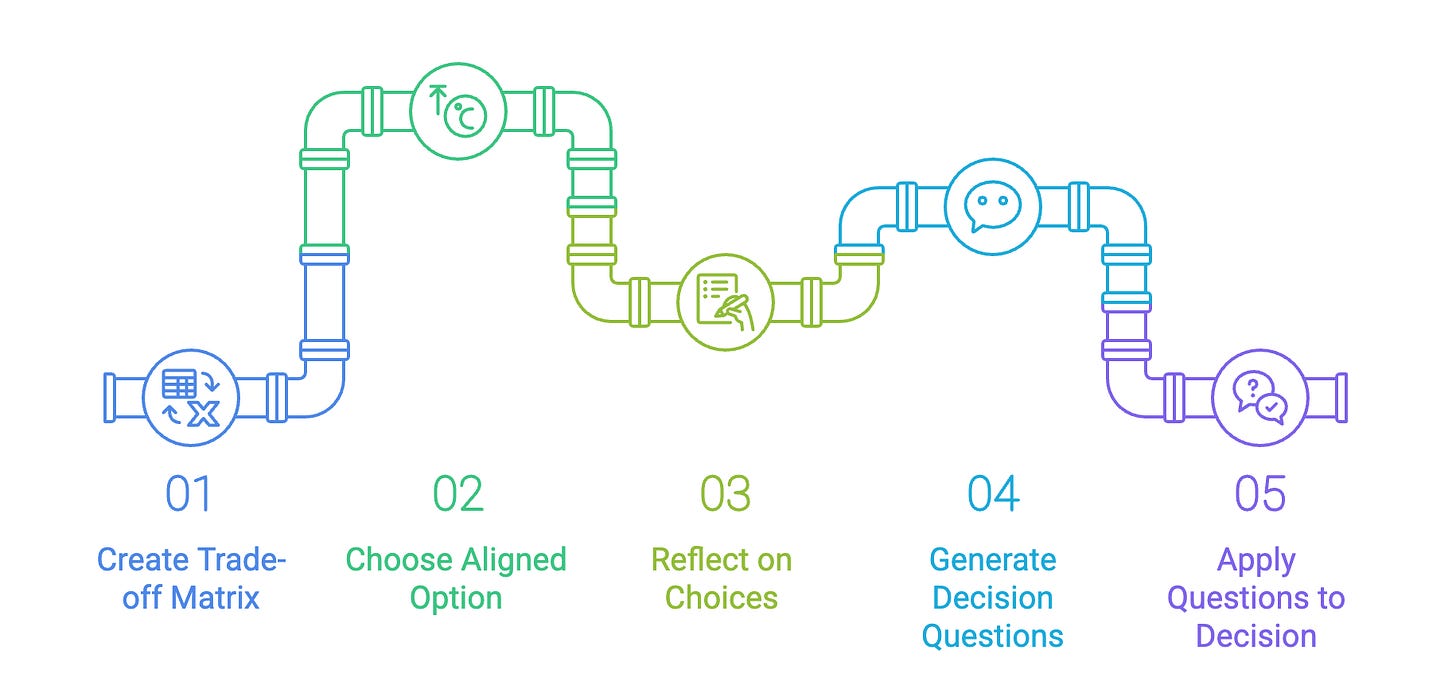Why Being Forced to Choose Revealed Everything
Sometimes life pushes you into clarity. Here’s how a forced resignation taught me the power of value-based decisions and changed everything.
What seems like many moons ago, I was offered a forced resignation, which I gladly accepted.
Was it on my terms and timeline? No.
Was it a blessing in disguise? You betcha.
For a good six months, I thought about leaving the company, but the salary was amazing and the schedule worked for me. Add to that, I’d built a dream team and hit every productivity mark.
The golden handcuffs were firmly in place.
Why it happened is a story for another day, but after the fact—when I had time to reflect—it was the universe talking to me.
I was overworked. Not as professionally driven. And my family needed me.
All the signs were there, but I was too comfortable (and too scared) to make the move myself.
“Here’s the thing about being pushed into change: it strips away all the comfortable lies we tell ourselves and forces us to see what actually matters.”
When Job Offers Flood In: How to Evaluate Opportunities Without Losing Yourself
In a highly competitive industry, I was one of the few without a no-compete clause. I could go anywhere and demand the world.
And the offers came in when word got out.
I was the needle in the haystack.
Every recruiter call felt like validation. Every offer felt like proof that I was valuable. For someone who’d just been pushed out of their comfort zone, this felt like the universe saying, “See? You’re going to be just fine.”
But then my better half reminded me of two things:
I was stressed by the schedule and workload
I would need to share secrets that most no-competes cover
Which was the deciding factor to pass on them all.
Here’s what I realized was actually happening: I wasn’t evaluating opportunities—I was reacting to them.
The real problem wasn’t finding the next job. It was figuring out what kind of work life I actually wanted to build.
Most people think the hard part about career transitions is finding opportunities.
It’s not. It’s knowing which ones to say no to.
The Integrity Test That Changed My Career Path Forever
Not because the workload would be heavy or the schedule wouldn’t fit.
Because integrity was the one thing that allowed me to soar at that company, and I was never going to compromise that.
This wasn’t just about non-compete clauses or trade secrets. This was about recognizing that my competitive advantage wasn’t what I knew—it was how I operated.
My integrity had been my differentiator all along.
What I’ve learned the hard way is that when you’re pushed into a corner, you discover what your actual boundaries are. Not the ones you think you have, but the ones you’ll actually defend when it matters.
I started with one simple experiment:
I wrote down what I would and wouldn’t do, regardless of the money offered.
The “wouldn’t do” list was shorter than I expected, but it was crystal clear. Any opportunity that asked me to cross those lines got an immediate no.
What worked was treating my values like a filter, not a suggestion.
What surprised me was how much easier decisions became once I knew where I wouldn’t bend. Instead of agonizing over every offer, I had a clear framework for evaluation.
“My next move became obvious: I was going to build something of my own, on terms that aligned with those non-negotiables.”
The forced resignation hadn’t just pushed me out of a job—it had pushed me toward clarity about what kind of business I wanted to build.
Decision-Making Framework: Build Your Personal Values Filter
Here’s the framework I developed from that experience, and what I now teach to avoid saying yes to opportunities that drain you:
The This or That Values Matrix: Start with trade-offs that show up often in your work. Create two columns and choose what feels more aligned with your current season:
Deep engagement vs. Big audience
Flexibility vs. Structure
Privacy vs. Visibility
Fast results vs. Sustainable growth
High pay vs. Meaningful work
Autonomy vs. Team collaboration
The Integrity Boundary Check: Before evaluating any opportunity, write down your non-negotiables. Not what you prefer, but what you absolutely won’t compromise on.
For me, it was integrity in how I handled confidential information.
For you, it might be:
Family time boundaries
Creative control requirements
Financial transparency standards
Work-life balance minimums
The Stress Test Question: Ask yourself: “If I took this path, what would I need to do that would make me lose respect for myself?”
This isn’t about being dramatic—it’s about being honest. The answer will tell you more about fit than any pro/con list.
The 10-Year Vision Filter: This is where I use a ChatGPT Project to build and refine my long-term vision over time. You can continuously add decisions, outcomes, and reflections to see patterns in what actually aligns with your bigger picture.
For one-time decision clarity, I created the Clara Decision Filter custom GPT that cuts through all the short-term pressure and gets to what actually matters. You can access it here: Clara Decision Filter.
According to a recent Harvard Business Review study, 67% of professionals report feeling overwhelmed by career decisions because they lack clear decision-making frameworks. This systematic approach helps cut through that overwhelm.
Build Your Personal Decision Filter in 15 Minutes
Watch me walk through the exact “this or that” matrix process I use to avoid saying yes to opportunities that drain me. You’ll get the ChatGPT prompts and Notion setup to create your own values-based decision system
Copy-Paste ChatGPT Prompt for Decision Questions:
I’m creating a set of tailored questions to help me make better decisions in my business that align with my needs. I started with a this or that matrix that reflects my preferences. Let’s talk about it.
[Paste your matrix choices and reflection notes here]
I prefer pinpointed reflective questions and would like you to factor in your findings, my matrix, and my core values to craft five key questions I can use when I need clarity on a decision.
Why Career Pressure Creates Better Decision-Making
This isn’t just about career transitions—it’s about recognizing that being pushed often reveals our clearest thinking.
We live in a world that celebrates the quick yes and the hustle mentality. However, the most successful builders I know have gotten really good at saying no to good opportunities so they can say yes to great ones.
The pattern is this: External pressure forces internal clarity.
When you’re comfortable, you can afford to be wishy-washy about your values. When you’re pushed, you find out what you actually stand for.
Here’s what I see happening with the entrepreneurs and creators I work with:
They get stuck not because they lack opportunities
But because they lack a clear framework for choosing between them
They’re evaluating everything on individual merits
Instead of filtering through their actual priorities
This same values-based filtering works for:
Partnership decisions (like the partnership that drained me in two weeks)
Client boundary setting
Business opportunity evaluation
Investment choices
“The most successful people aren’t the ones who say yes to everything—they’re the ones who know what to say no to.”
15-Minute Exercise: Find Your Decision-Making Framework
Pick one decision you’re currently wrestling with—could be a client opportunity, a partnership offer, or even a personal commitment.
Instead of making a pros and cons list, try this approach:
Step 1: Create your “this or that” matrix with 5-6 trade-offs relevant to this decision.
Step 2: Choose the option that feels more aligned with your current season (not what sounds good, but what feels right).
Step 3: Write down what these choices say about how you want to work.
Step 4: Use the ChatGPT prompt above to generate 5 core decision questions.
Step 5: Apply those questions to your current decision.
The goal isn’t to make the decision right now—it’s to build a system you can use repeatedly.
When Life Forces Clarity: Your Next Move
Looking back on that forced resignation, I realize it wasn’t just about leaving one job and finding another.
It was about being pushed into a moment of truth about what I actually valued and how I wanted to operate in the world.
The opportunities I turned down led to the business I built instead.
The integrity filter I developed in that moment of pressure became the foundation for every major decision I have made since then.
Here’s what I’m curious about: What decisions are you avoiding right now because you haven’t gotten clear on your own non-negotiables?
Sometimes, the best thing that can happen is life pushing you to find out.
Ready to build your own decision filter? The video above walks you through the complete system, and you can get the Clara Decision Filter custom GPT plus more frameworks like this at diginavcompass.news.
We’re building a space for you to experiment with these tools yourself, including creating a set of Context Library docs and a Story Refining system.
Because sometimes the best thinking partner isn’t human—it’s a well-designed system that helps you pause before you say yes to something that might not fit.



